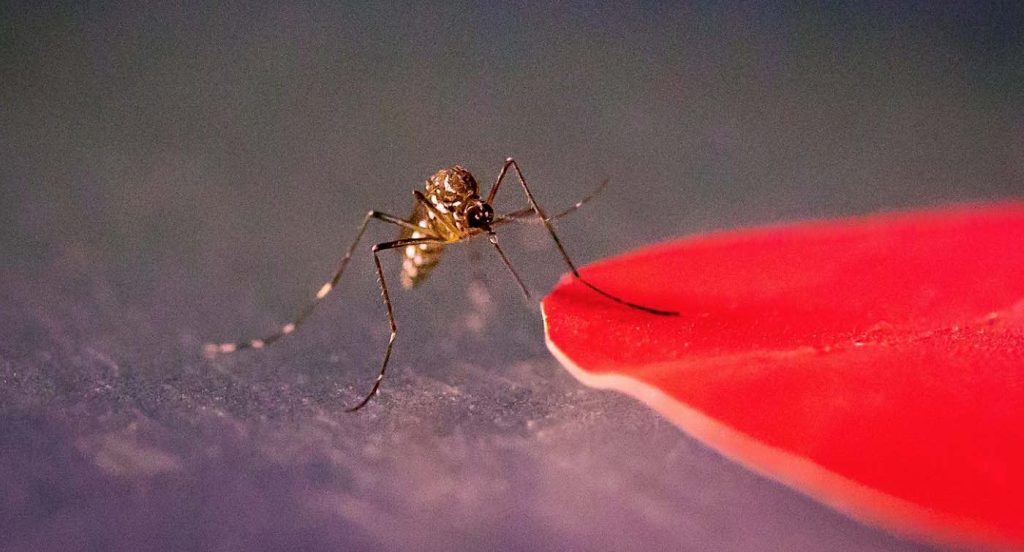
Finally, some research we can all use right away—especially if you’re prone to being bitten by mosquitoes more than anyone around you. It could hinge on what you wear.
New research led by scientists at the University of Washington indicates that a species of common mosquito flies toward specific colors, while ignoring the cooler shades of green, purple, blue and white.
On the other end of the color spectrum, human skin emits a strong red-orange signal for the mossies—and those are two of the colors that attract the bugs.
“Mosquitoes appear to use odors to help them distinguish what is nearby, like a host to bite,” said Jeffrey Riffell, a UW professor of biology. “When they smell specific compounds, like CO2 from our breath, that scent stimulates the eyes to scan for specific colors and other visual patterns… and head to them.”
“I used to say there are three major cues that attract mosquitoes: your breath, your sweat and the temperature of your skin, said Riffell, who is senior author on the paper.
“In this study, we found a fourth cue: the color red, which can not only be found on your clothes, but is also found in everyone’s skin. The shade of your skin doesn’t matter, we are all giving off a strong red signature. Wearing clothes that avoid those colors, could be another way to prevent a mosquito biting.”
The researchers tracked individual mosquitoes inside a test chambers where they sprayed specific odors and presented different types of visual patterns—such as a colored dots, human hands, or gloved hands.
Save your slimming black clothes for winter
Without any odor stimulus, mosquitoes largely ignored a dot at the bottom of the chamber, regardless of color. After a spritz of CO2 into the chamber, mosquitos continued to ignore the dot if it were green, blue or purple in color. But if the dot were red, orange, or black, mosquitoes would fly toward it.
RELATED: Science Shows What Actually Repels and Doesn’t Repel Mosquitoes – DEET, Citronella, Blood Type Myths Busted
Oddly, the color between green and blue on the spectrum—cyan—was also attractive to the creature.
Humans can’t smell CO2 (which we exhale with each breath), but mosquitoes can. Past research by Riffell’s team and other groups showed that smelling CO2 boosts female mosquitoes’ activity level—and they start searching the space around them, presumably for a host. The colored-dot experiments revealed that after smelling CO2, these mosquitoes’ eyes prefer certain wavelengths in the visual spectrum.
It’s similar to what might happen when humans smell something good.
“Imagine you’re on a sidewalk and you smell pie crust and cinnamon,” said Riffell. “That’s probably a sign that there’s a bakery nearby, and you might start looking around for it. Here, we started to learn what visual elements that mosquitoes are looking for after smelling their own version of a bakery.”
Most humans have “true color” vision: We see different wavelengths of light as distinct colors: 650 nanometers shows up as red; 450 nanometer appear blue. The researchers do not know whether mosquitoes perceive colors the same way that our eyes do. But most of the colors the mosquitoes prefer after smelling CO2 — orange, red and black — correspond to longer wavelengths of light. Human skin, regardless of pigmentation, also gives off a long-wavelength signal in the red-orange range.
POPULAR: New Online Map Shows You the Local Mosquito Forecast for the Week
When Riffell’s team repeated the chamber experiments with human skintone pigmentation cards — or a researcher’s bare hand — mosquitoes again flew toward the visual stimulus only after CO2 was sprayed into the chamber. If the researchers used filters to remove long-wavelength signals, or had the researcher wear a green-colored glove, then CO2-primed mosquitoes no longer flew toward the stimulus.
Riffell says knowing which colors attract hungry mosquitoes, and which ones do not, can also help design better repellants, traps, and other methods to keep mosquitoes at bay.
The paper, published Feb. 4 in Nature Communications, describes how the team used female yellow fever mosquitoes, Aedes aegypti, which are common in tropical, subtropical, and temperate regions throughout the world, and can transmit dengue, yellow fever, chikungunya and Zika. Like all mosquito species, only females drink blood.
More research is needed to determine if other mosquito species may have different color preferences, based on their preferred host. But these new findings add a new layer to mosquito control: color.
SHARE the Valuable Summer Tip With Friends on Social Media…
Credit: Source link


